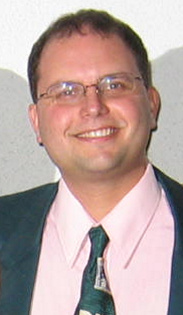
Inaugural Conference
2011
The Inaugural Imaging and Flow Cytometry Research Day was a huge success! Over 175 registrants and 16 vendors participated in the event.
Below are the featured presentations and abstracts from the 2011 Imaging and Flow Cytometry Research Day. Please click on the links to watch the full presentations and feel free to contact the presenters with any questions.
Title: "Systems Immunology at the Single Cell Level"
Garry Nolan, PhD, Rachford and Carlota A. Harris Professor, Baxter Laboratory in Genetic Pharmacology, Department of Microbiology and Immunology, Stanford University; Director, NHLBI Proteomics Center for Systems Biology at Stanford University
Abstract: Single cell analysis of functional cell states via flow cytometry has been an essential tool for dissecting the functional complexity of hematopoiesis. We have focused upon the development of intracellular assays of signaling systems can be correlated to functional subsets of cells in complex populations based on active kinase states or other signaling junctions. Such correlations could be important to document and order the immune system and its disorders into understandable progressions.
Using a next-generation single-cell ‘mass cytometry’ platform we quantify surface and cytokine or drug responsive indices of kinase targets with 34 parameters analysis (e.g. 31 antibodies, viability, DNA content and relative cell size). In healthy human blood and bone marrow, we identified cell subsets spanning the hematopoietic hierarchy using a panel of up to 31 surface markers and used an automated algorithm to delineate all cell subpopulations into a progressive hierarchy. Additionally, 18 simultaneous functional markers and a battery of ex vivo stimuli and inhibitors were used to interrogate signaling. This novel algorithm for unsupervised high-dimensional clustering of single-cell data revealed a continuum of phenotypically contiguous subpopulations. This continuum was demarcated by surface marker expression, but paralleled by gradual changes in intracellular signaling architecture.
The application of these multidimensional approaches to human acute lymphoid leukemia (ALL) and acute myeloid leukemia (AML) samples, as well as differentiating ES cells will be presented. The simultaneous measurement of surface marker, cell cycle, apoptosis, and intracellular signaling parameters has revealed substantial “order” within the presumed heterogeneity in the populations of these progressions of cell states. This information is used to provide a high-content view of differential in vitro drug activity across these distinct blast subpopulations for cancer—again indicating there exists remarkable “structure” within the tumor that is suggestive of either an adulterated differentiation cascade or a pseudo-hierarchy of differentiation. For differentiating ES cells we find signatures of pluripotent marker states that predict dead ends for differentiation or indicate a progression towards a defined lineage. Collectively, these results have exposed unappreciated layers of human hematopoietic organization, and provide an opportunity to re-evaluate diseases and pharmacological therapeutics as specific perturbations to this inherent order.
Title: “Consolidated Software for Flow and Image Cytometry”
David Novo, PhD, President, DeNovo Software
Abstract: Improvements and decreases in prices in imaging technology over the past five years has led to an explosion in Image Cytometry, loosely defined as generating multi-parameter data on many cells where the parameters are derived from mathematical analysis of images of the cells. The current state of the field mirrors the state of flow cytometry in the early 1980’s in that many different manufacturers are producing similar types of data but saving the data in proprietary and incompatible formats. It is well accepted that the FCS Standard has allowed for the existence of a healthy 3rd party flow cytometry data analysis market, which has been a critical element of the success of flow cytometry itself. Dr. Novo will discuss progress in standards for a new Image Cytometry data standard as well as describe and demonstrate key elements and challenges in developing a robust Image Cytometry Data Analysis software that provides the same level of sophistication as users are accustomed to in Flow Cytometry software.
Title: "SapC-DOPS Nanovesicles: Phospholipid-Selective Targeted Imaging"
Xioayang Qi, Associate Professor, University of Cincinnati
Title: "Sightomety at the Speed of Sight: Seeing is Believing"
Paul Robinson, PhD, SVM Professor of Cytomics, Purdue University
Abstract: Abstract: For about the last 30 odd years I have use the same old software approaches to the same old experimental formats. We have just become so comfortable with this approach we actually believe that it’s correct. I have heard it said, that cytometry people actually believe the earth is round! The problem is there are people that think its flat and the only alternative appears to be that it’s round. It’s not even close to round. There are bumps and holes and it’s even a bit warped. If you emptied out the oceans, almost no one would recognize any country any more. And what about those mountains? I know because I’ve been to the mountain top, and I know how hard it is to get there. Well, here is the good news: Cytometry analysis is going to get easier. And faster. And much more fun. You will be able to do those big picture systems biology experiments that you only dreamed about. It’s time. Don’t believe all the stuff people have been telling you. Revolt cytometrists! The world definitely needs more revolting cytometrists. Take your gates back. Restrict your Booleans. Burn your test tubes. Bring on the robots. Put your feet up on your desks and relax. You have all day, maybe all week, or even all month, to watch your colleagues slave and sweat over compensation, and sequencing their list mode files, hour after hour, day after day, let them sweat. You – just open a nice bottle of cab sav, relax, have some cheese and laugh a little before you click on the “send” button to submit your paper to Cytometry! Beware – superfast analysis is here!!




